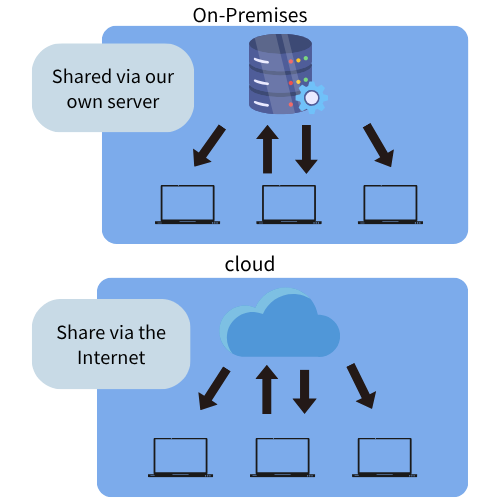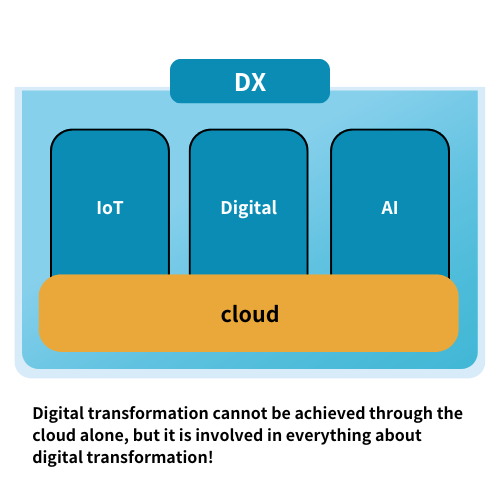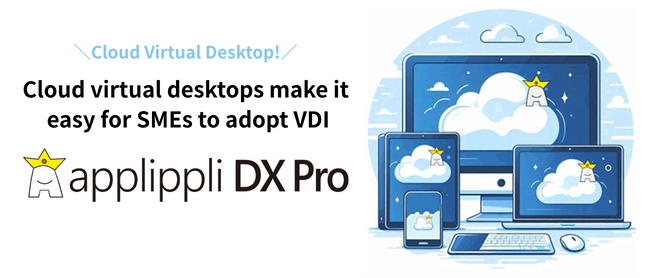Why dese cloud utilization lead to merit for promoting DX? Explaining the role of the cloud

Did you know that using the cloud has merit for promoting DX?
DX is an abbreviation for digital transformation, and many companies in modern business are introducing DX.
On the other hand, the cloud provides services over the Internet, and in Japan, where the communication environment is well developed, it has become indispensable for both individuals and corporations.
In fact, using the cloud to introduce and promote DX has a great merit.
The reason is that the cloud is called the “first step to DX,” and using the cloud to promote DX makes it easier to improve business efficiency.
However, there are probably many people who have concerns like, “I want to promote DX, but I don’t know where to start,” or “Is promoting DX really meaningful for my company?”
In this article, we will explain in detail why using the cloud has merit in promoting DX, and why it is necessary.
Those who should read this article
|
This article can be read in 3 minutes. Updated 2025/3/18
What is DX promotion?
DX: Abbreviation for digital transformation
According to the Ministry of Internal Affairs and Communications, what is DX?
Companies must respond to dramatic changes in the external ecosystem (customers, markets) while driving the transformation of their internal ecosystem (organization, culture, employees), and create value and establish a competitive advantage by using the third platform (cloud, mobility, big data/analytics, social technology) to transform customer experiences both online and offline through new products, services, and new business models.
Source)https://www.soumu.go.jp/johotsusintokei/whitepaper/ja/r03/html/nd112210.html
In other words, it does not just mean using technology to advance IT, but also refers to coordinated efforts to increase a company’s productivity and generate profits through new businesses and services in order to increase sales by using IT and digital technologies. Simply adopting digital technology does not mean DX; DX cannot be said to have been achieved unless digital technology is used to generate profits.
One example is reducing the burden and costs on employees, which leads to increased productivity and profits (maintaining and strengthening competitiveness). The work of promoting such efforts is called DX.
In other words, promoting DX refers to the act of adopting technology to increase productivity.
Why DX leads to improved business efficiency
Digital transformation has been widely covered in the media and through information on the internet as a way to improve business efficiency, so you are probably aware that introducing it will provide many merits, but do you know exactly what those merits are?
The current situation is that many people don’t understand what the merits of digital transformation are.
So what are the benefits of introducing digital transformation?
It’s because “using IT, IoT, and other technologies to improve business operations will alleviate labor shortages and further improve productivity, which will increase sales.”
As mentioned earlier, digital transformation can only be introduced once sales have increased.
Therefore, introducing digital transformation will lead to improved business efficiency.
So how can we introduce DX?
There are various companies and consulting companies that support the promotion of DX, but if you want to introduce it easily, we recommend using the cloud.
What is the cloud?
The cloud is a system that allows you to use the Internet without having to own your own server.
There are various types of cloud, but what they all have in common is that they refer to services that can be used anywhere (public cloud, private cloud, hybrid cloud).
By not installing a server in-house, you can reduce management costs and running costs. It also leads to BCP measures (business continuity planning measures).
Note) There are also on-premise private clouds that install servers in-house (⇔hosting type).
However, there is also the demerit that you end up with times when it is unavailable due to system maintenance or failures.
Incorporating these cloud technologies into your company’s workflow is called cloud utilization.
For more information, please see ➤ What is the cloud? Explaining the merits and demerits of using the cloud
Difference between on-premise and cloud
The main difference between on-premise and cloud is where the original data is running. The specific differences are explained in the table below.
| On-Premise | This is a system where you own and operate your own servers and PCs, install the system on the server, and operate software and services within a local network. Operating the server by yourself can stabilize the network environment. |
| Cloud | This is a system where users can use services over the Internet without having to own a server or software. By making good use of the cloud, you can enjoy various mertis, such as being able to work from anywhere and saving time. |
| On-Premise | This is a system where you own and operate your own servers and PCs, install the system on the server, and operate software and services within a local network. Operating the server by yourself can stabilize the network environment. |
| Cloud | This is a system where users can use services over the Internet without having to own a server or software. By making good use of the cloud, you can enjoy various mertis, such as being able to work from anywhere and saving time. |

Read also ➤ What is the difference between cloud and on-premise? How to migrate on-premise to cloud
Merits of cloud
Cloud has many merits. They can be broadly categorized as follows:
Information sharing | Unlike on-premise, the cloud stores data on the internet. Therefore, you can easily share information without using files or emails, as long as you can log in to your cloud account. This is useful for sharing information within the company and with external research organizations (such as tax accountant offices and outsourcing businesses). |
| Mobility | Cloud allows you to add or remove resources according to usage, thus you can flexibly respond to the expansion or contraction of your business. In addition, as long as you have an internet connection, you can use it from anywhere, whether you’re on the go or at home. |
| Recommended for those without IT knowledge | With cloud, the cloud operator manages the operation and management of servers and network equipment, therefore there is no need for you to manage operations in-house. This reduces the labor costs of operators and capital investment. In addition, cloud operators always provide the latest technology and security measures, so the operational burden can be reduced compared to managing operations in-house. |
Information sharing | Unlike on-premise, the cloud stores data on the internet. Therefore, you can easily share information without using files or emails, as long as you can log in to your cloud account. This is useful for sharing information within the company and with external research organizations (such as tax accountant offices and outsourcing businesses). |
| Mobility | Cloud allows you to add or remove resources according to usage, thus you can flexibly respond to the expansion or contraction of your business. In addition, as long as you have an internet connection, you can use it from anywhere, whether you’re on the go or at home. |
| Recommended for those without IT knowledge | With cloud, the cloud operator manages the operation and management of servers and network equipment, therefore there is no need for you to manage operations in-house. This reduces the labor costs of operators and capital investment. In addition, cloud operators always provide the latest technology and security measures, so the operational burden can be reduced compared to managing operations in-house. |
As you can see, the cloud has many merits. So, what is the relationship between the cloud and DX?
The relationship between DX and the cloud (merits)
Regarding the relationship between DX and the cloud, there is no doubt that the cloud is essential for introducing DX. The reason is that the cloud has become indispensable for improving business efficiency, and cloud services are incorporated into every IT system.
Given that, why is the cloud important in achieving DX?
As it is also shown as the cloud’s merits, the cloud can be used in a variety of businesses, such as facilitating information sharing, improving mobility, and being easy to introduce. By introducing the cloud, you can form the foundation for DX.

Here we explain why the cloud is necessary for DX in detail.
Why the cloud is necessary for DX
Facilitating information sharing
If you have not introduced cloud services other than email, you will probably share information by attaching data saved on your desktop or USB to an email.
This results in neither flexibility nor work efficiency.
If cloud computing can be introduced for information sharing, information sharing can be done in real time, eliminating the need to save data on a desktop or USB, and improving safety.
Since promoting digital transformation requires a variety of technologies, it is very important to centrally manage data and make information sharing easy.
Reduces the workload
Cloud services can reduce many business burdens and lead to labor savings.
The reason is that the cloud is more flexible than on-premise systems, and is easier to use in various business situations. For example, when using software or applications on the cloud, the data is not stored on the computer itself, so it can be used from computers other than the one you usually use, making it very convenient.
On the other hand, with on-premise systems, you cannot work without the computer you usually use, and if that computer becomes unusable for some reason, it will have a negative impact on your business.
Therefore, by utilizing cloud services, you can reduce your workload and save labor.
Also, if you want to use packaged software on the cloud, we recommend appippli Cloud.
Cloud is considered the “first step towards digital transformation” because of its ease of implementation [Table Explanation]
Cloud is easy to implement, and many people call it the “first step in DX”. The reasons are as follows.
1.Cost | Cloud pricing is basically subscription-based, so it is possible to significantly reduce the amount you need to pay per time. |
| 2.Maintenance and operation | As long as you have an internet connection, no prior preparation is required, and after implementation, the cloud operator will perform maintenance, so there is no hassle after implementation. |
| 3.Scalability | If you are using a server, it takes a lot of time and money to increase capacity, but with the cloud, you can easily change it with just one inquiry. |
1.Cost | Cloud pricing is basically subscription-based, so it is possible to significantly reduce the amount you need to pay per time. |
| 2.Maintenance and operation | As long as you have an internet connection, no prior preparation is required, and after implementation, the cloud operator will perform maintenance, so there is no hassle after implementation. |
| 3.Scalability | If you are using a server, it takes a lot of time and money to increase capacity, but with the cloud, you can easily change it with just one inquiry. |
As such, introducing the cloud produces great merits in achieving DX.
Related article ➤ If you don’t know how to proceed with DX, we recommend the cloud! The easiest way to proceed with DX
Cloud services that contribute to promoting DX
■applippli Cloud Desktop
This service is a type of virtual desktop service DaaS_ (Desktop as a service), and by incorporating downloadable business software (accounting software, Excel, quotation software, etc.) into the cloud environment, you can now use software that previously only operated in designated locations on the go, at home, at sales offices, branches, etc.
In addition, you can access the cloud environment from tablet devices such as iPads, making a significant contribution to promoting digital transformation.
Summary
In order to realize digital transformation, there are various difficulties, so it is important to know how to reduce the work and tasks that are currently being done. Therefore, one way to easily realize digital transformation is to realize digital transformation by introducing a cloud that is easy to implement and can easily reduce the labor of work. If you are interested in cloud services, please contact us. |
We offer our own proprietary “applippli Cloud”, which puts all business software on the cloud, and “applippli Cloud Desktop”, which puts the desktop environment on the cloud as it is. Here is a page that lists all the services we offer. ➤applippli Platform
We also provide a lot of useful information about other clouds. ➤Useful information about clouds and back offices
The official company X (formerly Twitter) is here! ➤https://x.com/Applippli_Staff
The official YouTube channel is here! ➤https://www.youtube.com/channel/UCBYyLPkyDfLbeqX00aVoYLA
■Company profile Company name: applippli Co., Ltd. Address: 875-2 Yamano, Kama City, Fukuoka Prefecture, 820-0202 Business: Cloud conversion of Yayoi products, module design and development, app development, app rental,System integrator, core system implementation and maintenance Phone number: 0948-42-1570 URL:https://applippli.co.jp/en/ |

